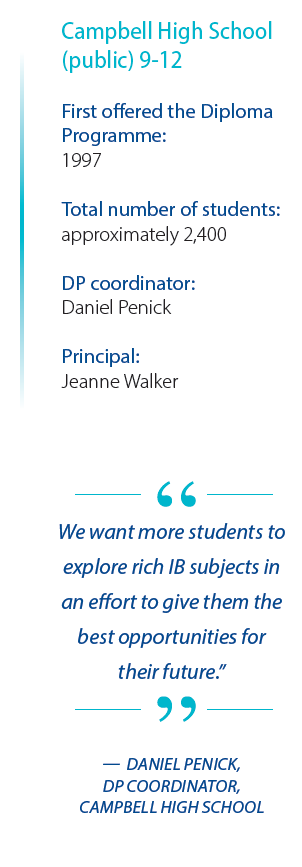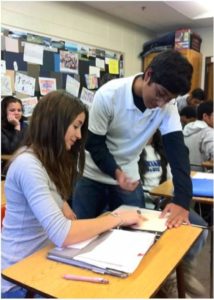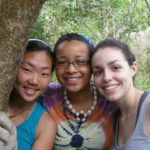Case study: Diploma Programme (DP)
 Like other IB World Schools, Campbell High School attracts students with its Diploma Programme. Then it goes a step further by supporting them with a system designed to make sure they succeed in the programme.
Like other IB World Schools, Campbell High School attracts students with its Diploma Programme. Then it goes a step further by supporting them with a system designed to make sure they succeed in the programme.
When Campbell High School in Smyrna, Georgia (US), wanted a program to attract students from outside its traditional attendance zone, it chose the Diploma Programme (DP). Almost 20 years later, the mission has been accomplished: now, two-thirds of Campbell’s DP students come from outside this area.

The school and its DP coordinator, Daniel Penick, continue efforts to grow the programme. “We see the great benefits as students develop their academic and personal skills in preparation for university and careers,” Penick says, “and we want more students to explore rich IB subjects in an effort to give them the best opportunities for their future. We also want all of our students to have a global mindset as they prepare to enter the world’s workforce.”
In order to attract and retain DP students, the school takes a two-pronged approach. First, it reaches out across the entire school district, including areas where it had not previously sought students. “I meet with parent groups, visit middle schools, host information nights, attend community events and find any other avenue possible to share information about the DP at our school,” Penick says. Between September and March, he spends about 20 hours per week on such events. Consequently, Campbell is receiving much more interest from large numbers of students and
parents.
In addition, the school strengthened support systems for 9th- and 10thgraders to help them approach DP subjects more confidently in grades 11 and 12. Older students mentor the younger ones, and both teachers and students offer tutoring to provide extra help. “We are building a culture that everyone can be successful across the board,” Penick says. “That has resulted in a higher rate of retention for students entering the DP years, which means more Diploma candidates by the end of 12th grade.”
Seven years ago, 260 students were committed to the school’s Diploma Programme. This year, there are 500. That increase happened despite funding challenges and the rise of STEM (science, technology, engineering and math) programs in the area. The state subsidizes costs of students’ DP exams, but the amount has not increased significantly as more students take the exams. Penick notes that some parents and students mistakenly think the DP does not provide a rigorous education in science and math, a misperception that IB research dispels and Penick works hard to correct.
 “Many students appreciate the balance of academic opportunities that the DP provides,” Penick says. “The highest achievers recognize the value of history, language, philosophy, art and many other subjects that make them better rounded for college and career opportunities.”
“Many students appreciate the balance of academic opportunities that the DP provides,” Penick says. “The highest achievers recognize the value of history, language, philosophy, art and many other subjects that make them better rounded for college and career opportunities.”
Also appreciated is the success of DP students’ acceptance into universities of their choice and being awarded scholarships. That kind of achievement brings attention to the programme, Penick says, which enables him and his Campbell colleagues to explain the real value of the DP — the excellent academic preparation, the commitment to service and the chance to learn how to conduct research.
“The DP is compelling because of its balance and global nature,” Penick says. “We want students who are competitive in a variety of areas, while able to think and communicate in any context, especially global. The DP is the only preparatory programme that provides such opportunities.”


Some schools require students to test into the Diploma Programme; some schools accept all students who apply to the programme; and some schools offer the DP as the only option. Campbell High School takes a different approach.
Prospective DP students apply online in the 8th grade to attend Campbell in the Diploma Programme for four years. “Their grades, standardized test scores and teacher recommendations are reviewed,” DP coordinator Daniel Penick says, “and students are accepted into the programme if we feel they are a good fit for our school and programme.” The school looks for students who have academic potential, are curious about a wide range of topics, are interested in service and leadership and will be good classmates, he explains.
